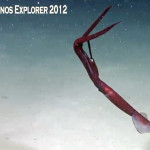
The Challenger expedition of 1872-76 marks the transition form Victorian to modern science: from the world of the gentleman naturalist to the of Big Science, with its requisite institutional, collaborative and multidisciplinary framework and national funding support

Out of this 3.5 year, 69,000 mile expedition came 50 volumes of numerous pages covering every known phylum of organisms collected during the trip. Yesterday a reader noted, and I very excited to pass on, a link for the Challenger Reports. This online gift is the full 50 volumes with the beautifully illustrated plates. As a colleague of mine stated correctly, these reports contain the very first formal descriptions for many marine species (4,370 exactly, with over half being >200m). Koslow states that the “monumental effort…laid the foundations for modern oceanography.” Under a committee of some of the era’s most influential scientists, William Carpenter, Wyville Thomson, John Gywn Jeffreys, Joseph Hooker, and Thomas Henry Huxley the objectives were set forth to document:
- The physical conditions of the deep sea
- The chemical composition of seawater at all depths
- The physical and chemical characteristics of the seafloor
- The distribution of live
 The House of Commons approved funding in the spring of 1872 for the expedition and the 226 ft H.M.S. Challenger, a mixed steam and sail corvette, was chosen. As the ship was a commissioned military vessel, the cannons were removed and laboratories built. By Christmas of the same year, the ship had set sail to the North Atlantic. Amazingly, the at sea operations for such an audacious field plan were carried about by just five scientists-Buchanan (chemistry), von WillimoesSuhm (who dies on the voyage), Moseley (naturalist), Murray, and Thomson. Koslow notes “Whereas a major oceanographic project today might enlist several specialists to sample the plankton alone, Thomson set out in his reply to the Admiralty a sampling program for his small band of naturalists that would map out the broad outline of physical, chemical, geological, and biological oceanographic science for the next century.”
The House of Commons approved funding in the spring of 1872 for the expedition and the 226 ft H.M.S. Challenger, a mixed steam and sail corvette, was chosen. As the ship was a commissioned military vessel, the cannons were removed and laboratories built. By Christmas of the same year, the ship had set sail to the North Atlantic. Amazingly, the at sea operations for such an audacious field plan were carried about by just five scientists-Buchanan (chemistry), von WillimoesSuhm (who dies on the voyage), Moseley (naturalist), Murray, and Thomson. Koslow notes “Whereas a major oceanographic project today might enlist several specialists to sample the plankton alone, Thomson set out in his reply to the Admiralty a sampling program for his small band of naturalists that would map out the broad outline of physical, chemical, geological, and biological oceanographic science for the next century.”
pictures are all from the Library of 19th Century Science at the link above






This is a great resource. I am glad to see so much of this material is available online. The first thing I had to do was go and find the Globigerina plate in the foram report.